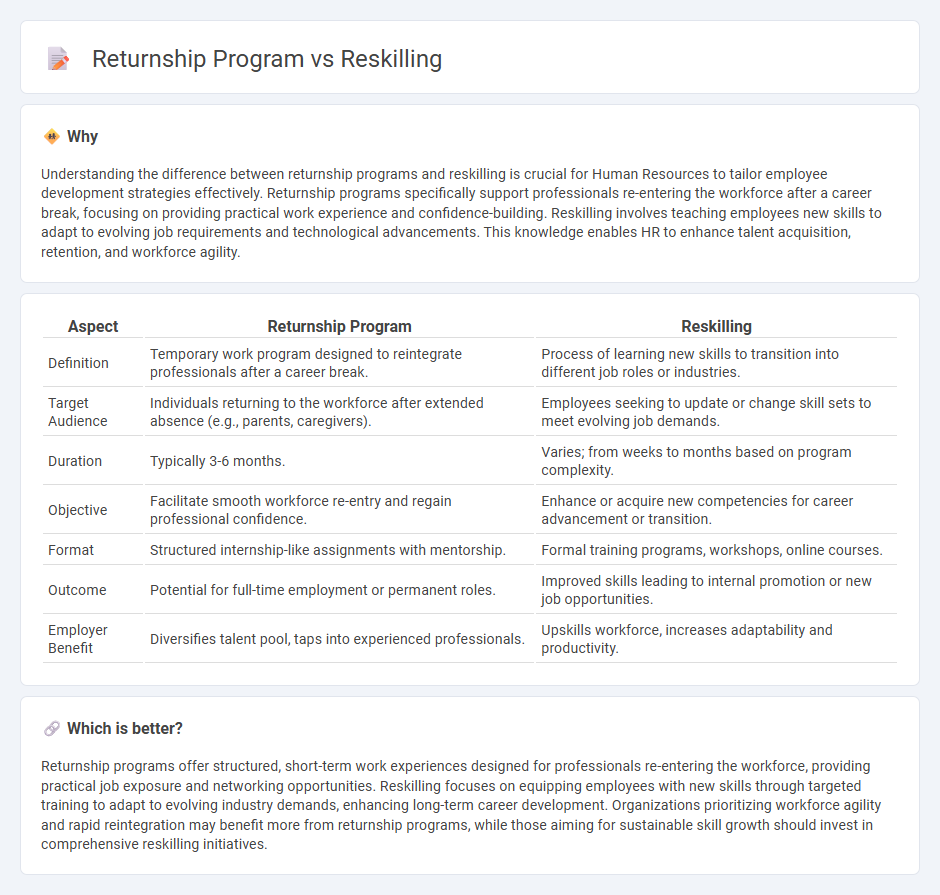
Returnship programs offer structured opportunities for experienced professionals to re-enter the workforce after career breaks, often focusing on real-world projects and mentorship to rebuild confidence and skills. Reskilling initiatives emphasize acquiring new competencies or updating existing ones to adapt to evolving job requirements, leveraging training modules tailored to current industry demands. Explore in-depth strategies for optimizing talent reintegration and skill development through returnship and reskilling programs.
Why it is important
Understanding the difference between returnship programs and reskilling is crucial for Human Resources to tailor employee development strategies effectively. Returnship programs specifically support professionals re-entering the workforce after a career break, focusing on providing practical work experience and confidence-building. Reskilling involves teaching employees new skills to adapt to evolving job requirements and technological advancements. This knowledge enables HR to enhance talent acquisition, retention, and workforce agility.
Comparison Table
| Aspect | Returnship Program | Reskilling |
|---|---|---|
| Definition | Temporary work program designed to reintegrate professionals after a career break. | Process of learning new skills to transition into different job roles or industries. |
| Target Audience | Individuals returning to the workforce after extended absence (e.g., parents, caregivers). | Employees seeking to update or change skill sets to meet evolving job demands. |
| Duration | Typically 3-6 months. | Varies; from weeks to months based on program complexity. |
| Objective | Facilitate smooth workforce re-entry and regain professional confidence. | Enhance or acquire new competencies for career advancement or transition. |
| Format | Structured internship-like assignments with mentorship. | Formal training programs, workshops, online courses. |
| Outcome | Potential for full-time employment or permanent roles. | Improved skills leading to internal promotion or new job opportunities. |
| Employer Benefit | Diversifies talent pool, taps into experienced professionals. | Upskills workforce, increases adaptability and productivity. |
Which is better?
Returnship programs offer structured, short-term work experiences designed for professionals re-entering the workforce, providing practical job exposure and networking opportunities. Reskilling focuses on equipping employees with new skills through targeted training to adapt to evolving industry demands, enhancing long-term career development. Organizations prioritizing workforce agility and rapid reintegration may benefit more from returnship programs, while those aiming for sustainable skill growth should invest in comprehensive reskilling initiatives.
Connection
Returnship programs and reskilling initiatives are interconnected strategies that address workforce reintegration challenges by providing structured opportunities for professionals re-entering the job market to update and expand their skill sets. These programs focus on equipping participants with contemporary competencies through targeted training, aligning their abilities with current industry standards and organizational needs. The synergy between returnships and reskilling enhances talent retention, diversifies the workforce, and supports continuous career development within human resources management.
Key Terms
Upskilling
Upskilling enhances employees' existing skills to meet evolving industry demands, while reskilling involves learning entirely new competencies for a different role. Returnship programs specifically support professionals re-entering the workforce after a career break by offering structured training and hands-on experience. Discover how these initiatives can transform career trajectories and business growth.
Career Reentry
Reskilling programs equip professionals with new skills tailored to evolving industry demands, enhancing employability during career reentry phases. Returnship programs offer structured internships designed specifically for individuals reentering the workforce after career breaks, providing hands-on experience and mentorship. Explore detailed comparisons and insights to determine which pathway best supports your successful career comeback.
Workforce Adaptability
Reskilling programs equip employees with new skills to meet evolving job demands, enhancing workforce adaptability by addressing skill gaps and fostering continuous learning. Returnship programs, designed for professionals re-entering the workforce after a career break, provide tailored support and hands-on experience, aiding reintegration and promoting diversity. Explore the benefits of these initiatives to optimize talent development and boost organizational resilience.
Source and External Links
Difference Between Reskilling, Upskilling & New Skilling - Explores reskilling, which involves training employees in entirely new skills to move into different roles, often due to technological changes.
What Is Reskilling? - Describes reskilling as a strategy to train current employees with new skills, enabling them to transition into new roles effectively.
Guide: The Importance of Reskilling - Discusses reskilling as the process of acquiring new skills for a completely different role, highlighting its importance in workforce development.
 dowidth.com
dowidth.com